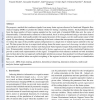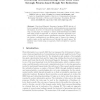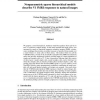125
Voted
TNN
2010
14 years 7 months ago
2010
Statistical learning methods are emerging as a valuable tool for decoding information from neural imaging data. The noisy signal and the limited number of training patterns that ar...
JOCN
2011
14 years 7 months ago
2011
■ Emerging evidence indicates that stimulus novelty is affectively potent and reliably engages the amygdala and other portions of the affective workspace in the brain. Using fun...
138
Voted
ICONFERENCE
2011
14 years 7 months ago
2011
The author proposed three studies (i.e. a large-N survey, a behavioral experiment, and a functional magnetic resonance imaging research) to investigate whether people read icons a...
122
Voted
CORR
2011
Springer
14 years 7 months ago
2011
Springer
We propose a method that combines signals from many brain regions observed in functional Magnetic Resonance Imaging (fMRI) to predict the subject’s behavior during a scanning se...
126
Voted
ICASSP
2009
IEEE
14 years 10 months ago
2009
IEEE
In this paper, a novel non-stationary model of functional Magnetic Resonance Imaging (fMRI) time series is proposed. It allows us to account for some putative habituation effect a...
121
Voted
ACL
2009
14 years 10 months ago
2009
Recent advances in functional Magnetic Resonance Imaging (fMRI) offer a significant new approach to studying semantic representations in humans by making it possible to directly o...
100
Voted
IJON
2008
15 years 19 days ago
2008
Real-world data sets such as recordings from functional magnetic resonance imaging often possess both spatial and temporal structure. Here, we propose an algorithm including such ...
122
Voted
HAIS
2008
Springer
15 years 1 months ago
2008
Springer
Abstract. Functional Magnetic Resonance Imaging (fMRI) data is collected ceaselessly during brain research, which implicates some important information. It need to be extracted and...
116
Voted
NIPS
2007
15 years 2 months ago
2007
We construct a biologically motivated stochastic differential model of the neural and hemodynamic activity underlying the observed Blood Oxygen Level Dependent (BOLD) signal in Fu...
102
Voted
NIPS
2008
15 years 2 months ago
2008
We propose a novel hierarchical, nonlinear model that predicts brain activity in area V1 evoked by natural images. In the study reported here brain activity was measured by means ...



